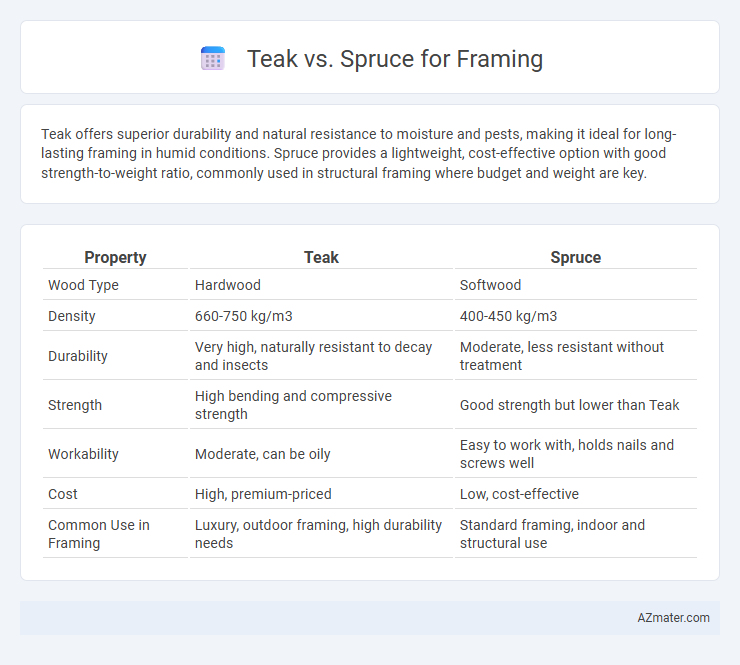Teak offers superior durability and natural resistance to moisture and pests, making it ideal for long-lasting framing in humid conditions. Spruce provides a lightweight, cost-effective option with good strength-to-weight ratio, commonly used in structural framing where budget and weight are key.
Table of Comparison
| Property | Teak | Spruce |
|---|---|---|
| Wood Type | Hardwood | Softwood |
| Density | 660-750 kg/m3 | 400-450 kg/m3 |
| Durability | Very high, naturally resistant to decay and insects | Moderate, less resistant without treatment |
| Strength | High bending and compressive strength | Good strength but lower than Teak |
| Workability | Moderate, can be oily | Easy to work with, holds nails and screws well |
| Cost | High, premium-priced | Low, cost-effective |
| Common Use in Framing | Luxury, outdoor framing, high durability needs | Standard framing, indoor and structural use |
Introduction to Teak and Spruce as Framing Materials
Teak offers exceptional durability, natural resistance to moisture, and termite attacks, making it a premium choice for framing in high-end construction projects. Spruce, known for its lightweight strength and straight grain, is widely used in framing due to its cost-effectiveness and ease of handling. Both materials provide distinct advantages depending on structural requirements and environmental conditions.
Physical Properties Comparison: Teak vs Spruce
Teak wood exhibits superior durability and natural resistance to decay, with a density of approximately 650 kg/m3, making it highly suitable for long-lasting framing projects. Spruce, with a lower density near 400 kg/m3, offers lighter weight and greater ease of handling but has less resistance to moisture and insect damage. The higher Janka hardness rating of teak, around 1,070 lbf, compared to spruce's 510 lbf, indicates better wear resistance and structural strength for demanding framing applications.
Durability and Longevity
Teak offers exceptional durability and longevity in framing due to its natural oils that resist rot, insects, and moisture, making it ideal for outdoor and high-humidity environments. Spruce, while lightweight and easier to work with, lacks the natural resistance of teak and requires protective treatment to prevent decay and extend its lifespan. In terms of longevity, teak frames can last several decades with minimal maintenance, whereas spruce frames generally have a shorter lifespan and are more vulnerable to environmental damage.
Resistance to Pests and Decay
Teak wood offers exceptional resistance to pests and decay due to its natural oils and dense grain, making it highly durable for framing in harsh environments. Spruce, while commonly used in framing, is more susceptible to insect infestations and rot without proper treatment or maintenance. Choosing teak over spruce ensures longer-lasting structural integrity in pest-prone or humid conditions, reducing maintenance costs and increasing overall frame longevity.
Workability and Ease of Construction
Teak offers superior durability and resistance to moisture, but its dense grain can make cutting and nailing more challenging compared to spruce. Spruce is favored for framing due to its lightweight nature and ease of handling, allowing faster installation and reduced labor costs. The workability of spruce makes it ideal for large-scale construction projects, while teak suits specialized applications requiring long-term structural integrity.
Cost and Availability
Teak is significantly more expensive than spruce due to its durability and limited availability, making it a premium choice for framing projects. Spruce is widely available in North America and Europe, providing an affordable and accessible option commonly used in construction framing. Cost-effectiveness and material accessibility make spruce the preferred choice for large-scale framing, whereas teak is reserved for high-end, specialized applications.
Environmental Impact and Sustainability
Teak offers superior durability and natural resistance to pests but requires longer growth cycles, raising concerns about deforestation and habitat loss. Spruce grows rapidly, making it a more renewable choice with lower carbon footprint in framing applications, especially when sourced from responsibly managed forests. Selecting FSC-certified spruce supports sustainable forestry practices, reducing environmental impact compared to teak harvested from uncontrolled logging regions.
Aesthetic Differences in Framing Applications
Teak offers a rich golden-brown hue with a natural oily finish that enhances its luxurious appearance in framing applications, contrasting sharply with spruce's pale, creamy white color and smooth, fine grain. Spruce frames often provide a more understated aesthetic, emphasizing minimalist or rustic designs, while teak frames deliver a bold, elegant statement due to their darker tones and natural luster. Both woods exhibit different aging characteristics; teak darkens gracefully over time, maintaining durability and visual appeal, whereas spruce may require finishing treatments to protect its lighter surface and preserve its aesthetic quality.
Best Use Cases: Teak vs Spruce
Teak is highly valued for framing in outdoor and high-moisture environments due to its natural resistance to rot, insects, and warping, making it ideal for decks, marine structures, and exterior home framing. Spruce is preferred for interior framing where strength and cost-effectiveness are priorities, commonly used in residential construction and cold climates because of its lightweight yet durable properties. Choosing between teak and spruce depends on environmental exposure, budget constraints, and the need for durability versus economic efficiency.
Conclusion: Choosing the Right Wood for Framing
Teak offers superior durability and natural resistance to moisture and pests, making it ideal for long-lasting, high-quality framing projects, especially in humid environments. Spruce, being lightweight and cost-effective, is a favorable choice for standard framing tasks where budget and ease of handling are priorities. Selecting the right wood depends on balancing project demands, environmental conditions, and long-term performance requirements.

Infographic: Teak vs Spruce for Framing
 azmater.com
azmater.com